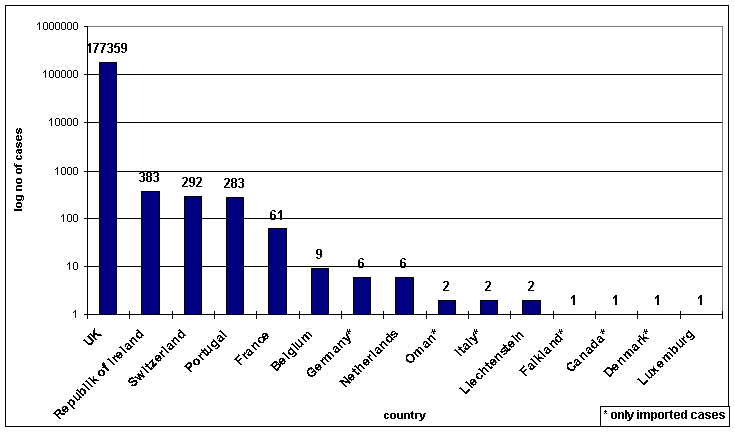
Review of the international BSE situation and surveillance of BSE
U. Kihm and D. Heim
Swiss Federal Veterinary Office, Bern, Switzerland
The international situation
Bovine spongiform encephalopathy (BSE) was first described in the United Kingdom in 1986. The first native cases outside the UK occurred in Ireland in 1989; in Switzerland in 1990, and in France in 1991. In 1997, the first cases were diagnosed in Belgium, the Netherlands and Luxembourg. Indigenous cases have been diagnosed in nine countries and imported cases in six countries (Figure 1).
Figure 1: Number of clinical BSE cases in the world

While the number of cases in the United Kingdom and Switzerland is steadily declining, the trend in other countries is not that obvious (Figure 2).
The reported number of BSE-cases in a country has to be seen in the light of the quality of its surveillance system and the measures taken. Detection of cases depends on effective surveillance, which depends on disease awareness and on the willingness to notify suspected cases. Therefore, the numbers reported must be interpreted with precaution. Reporting is usually based on the observation of clinical signs which must be notified by the owner and/or the veterinarian.
In all countries surveillance is targeted at animals showing clinical signs compatible with BSE; the most important of these are hypersensitivity to manipulation of the head and neck, and disturbances in behaviour and locomotion. Reduced milk yields and loss of weight are also frequently seen. Usually the symptoms are very mild at the beginning of the clinical stage. Because active detection of asymptomatic cases in the population at risk has not been implemented up to now, the true prevalence of the disease in the different countries is not known. Under these circumstances new tools must be developed in order to get the true picture, before a country can be declared free from disease.
Figure 2: Number of clinical BSE-cases by year for six European countries as of June 1999

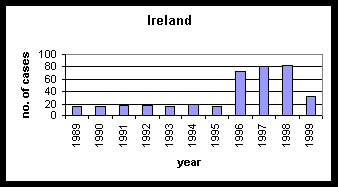
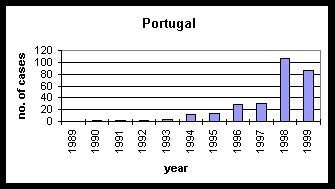

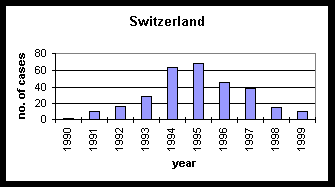
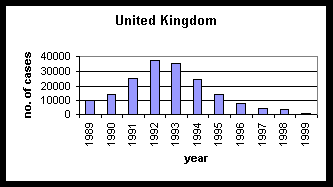
The OIE position
During the General Session of the OIE in May 1999 a modified BSE-chapter of the International Animal Health Code was adopted. The Chapter was amended with particular reference to the sections that had previously remained „under study" and taking into account the proposals of an ad hoc group and the comments of member countries. Other sections are now „under study" and need further clarification by an ad hoc group of the OIE.
Although it was mentioned that countries „traditionally free from BSE" could use less stringent declaration criteria, it was pointed out that infected material had circulated throughout the world and, therefore, a risk analysis would be essential to determine the BSE status of a country.
Such a risk analysis has to take into account the items listed below, by means of which one could evaluate whether potentially infected material was imported and whether the conditions in the country are sufficient to cope with potentially affected material:
As mentioned before, the number of cases alone cannot give a real picture of the BSE situation in a given country. Using a risk assessment, the reliability of the reported number of cases can be evaluated.
Although the OIE considers implementation of the following measures (i-iv) not as part of the risk analysis, they have to be considered:
i) compulsory notification and investigation of all cattle showing clinical signs compatible with BSE; and
ii) a BSE surveillance and monitoring system with emphasis on risks identified; taking into account already existing guidelines -- records of the number and results of investigations should be maintained for at least 7 years.
Guidelines for maintaining an efficient surveillance system are laid down in the Animal Health Code in a separate Annex. The main feature is that for the purpose of surveillance, a given proportion of the cattle population has to be investigated. In decreasing order of relevance, the following categories of cattle should be sampled:
Because in many countries the number of animals displaying nervous disorders is much smaller than the number of samples requested, the requirements of the guidelines for surveillance (ii) will be re-examined by the ad hoc group of the OIE.
iii) an on-going education programme for veterinarians, farmers, and workers involved in transportation, marketing and slaughter of cattle, so as to encourage reporting of all cases of neurological disease in adult cattle;
iv) examination in an approved laboratory of brain or other tissues collected within the framework of the aforementioned surveillance system.
Four categories of countries are defined based on the number of BSE-cases reported, on the risk analysis carried out and on the measures implemented (table 1-3).
The BSE-free status was foreseen for countries with no native cases or which have eradicated the disease. The BSE provisionally free status was introduced for countries which have no indigenous cases, but where some of the other conditions mandatory for a BSE free status are not met. Countries with a small number of cases have now the possibility to get the provisionally free status. There was animated discussion whether countries with a small number of cases should have the possibility to get the provisionally free status and about the acceptable level of reported cases during the last seven-year period. The proposed acceptable level of "less than one case per million annually" has to be clarified by an ad hoc group. An additional requirement for countries with a small number of cases is the slaughtering and complete destruction of the affected cattle, the offspring and all cattle reared with the affected cattle. Nevertheless, the definition of "cattle reared with the affected animal" is not clear; therefore, the procedures, time periods and measures are still "under study". This expression could be understood to mean total herd slaughter, or slaughtering of a specific birth cohort; the latter would be a more targeted approach.
In the chapter of 1998, the definitions of low and high incidence were "under study" and are now defined.
If a country has never recorded native BSE cases or if it has eradicated the disease (i.e., has had no cases over a period of 7 years), a BSE free or provisionally free status can be declared, depending on the time period the measures (i-iv) have been implemented. For countries which can provide proof that no MBM was fed over the 8 previous years, more relaxed conditions are given. If BSE cases were reported in imported cattle, slaughter and complete destruction of the affected animal and its offspring is necessary.
In contrast to the proposal of the Code Commission of September 1998, countries with no case, but for which a risk analysis demonstrates the presence of a risk factor, is no more included in the category of low incidence; the categorisation of these countries remains unclear.
If a country had less than one case per million for the last 7 years, the provisionally free or low incidence status will be declared depending on the time the measures have been implemented.
A country with up to 100 cases per million in the cattle population over 24 months, calculated over the past 12 months, is classified as either a low or a high incidence country depending on the measures implemented.
A country with more than 100 cases per million is in the high incidence category.
Table 1: BSE status for countries with no native BSE cases
|
Status |
free |
prov. free |
free |
prov. free |
free |
prov. free |
free |
prov. free |
|
No. of cases |
never recorded |
never recorded |
never recorded |
never recorded |
in imported cattle only |
in imported cattle only |
in imported cattle only |
in imported cattle only |
|
Risk analysis |
+ |
+ |
+ |
+ |
+ |
+ |
+ |
+ |
|
No MBM feeding |
- |
- |
+(8 yrs) |
+(8 yrs) |
- |
- |
+(8 yrs) |
+(8 yrs) |
|
Measures |
||||||||
|
If cases |
affected + offspring slaughtered |
affected + offspring slaughtered |
affected + offspring slaughtered |
affected + offspring slaughtered |
||||
|
Compulsory notification according to i) |
+(7 yrs) |
+(< 7 yrs) |
+(7 yrs) |
+(< 7 yrs) |
+(7 yrs) |
+(< 7 yrs) |
+(7 yrs) |
+(< 7 yrs) |
|
Surveillance according to ii) |
+(7 yrs) |
+(< 7 yrs) |
- |
- |
+(7 yrs) |
+(< 7 yrs) |
- |
- |
|
Education according to iii) |
+(7 yrs) |
+(< 7 yrs) |
- |
- |
+(7 yrs) |
+(< 7 yrs) |
- |
- |
|
Examination in labs according to iv) |
+(7 yrs) |
+(< 7 yrs) |
- |
- |
+(7 yrs) |
+(< 7 yrs) |
- |
- |
Table 2: BSE status for countries which have eradicated the disease
|
Status |
free |
prov. free |
prov. free |
|
No. of cases |
0, since 7 yrs |
0, since 7 yrs |
0, since 7 yrs |
|
Risk analysis |
+ |
+ |
+ |
|
No MBM feeding |
+(8 yrs) |
+(8 yrs) |
+(<8 yrs) |
|
Measures |
|||
|
If cases |
- |
- |
- |
|
Compulsory notification according to i) |
+(7 yrs) |
+(< 7 yrs) |
+(7 yrs) |
|
Surveillance according to ii) |
+(7 yrs) |
+(< 7 yrs) |
+(7 yrs) |
|
Education according to iii) |
+(7 yrs) |
+(< 7 yrs) |
+(7 yrs) |
|
Examination in labs according to iv) |
+(7 yrs) |
+(< 7 yrs) |
+(7 yrs) |
Table 3: BSE status for countries with native BSE cases
|
Status |
prov. free |
low incidence |
low incidence |
high incidence |
high incidence |
|
No. of cases |
< 1 case / million annually for the last 7 years |
< 1 case / million for the last 12 months |
1-100 cases /million for the last 12 months |
1-100 cases /million for the last 12 months |
>100 cases /million for the last 12 months |
|
Risk analysis |
+ |
+/- |
+ |
+/- |
+ |
|
No MBM feeding |
+(8 yrs) |
- |
- |
- |
- |
|
Measures |
- |
one criteria of provisional free not complied with |
- |
one criteria of requirements of low incidence not complied with |
- |
|
If cases |
affected+offspring +cattle reared with affected slaughtered |
- |
- |
- |
- |
|
Compulsory notification according to i) |
+(7 yrs) |
+/- |
+ |
+/- |
+ |
|
Surveillance according to ii) |
+(7 yrs) |
+/- |
+ |
+/- |
+ |
|
Education according to iii) |
+(7 yrs) |
+/- |
+ |
+/- |
+ |
|
Examination in labs according to iv) |
+(7 yrs) |
+/- |
+ |
+/- |
+ |
The EU position
According to the OIE, the BSE status of a country can only be determined on the basis of the outcome of a risk analysis. To carry out a risk assessment is a cumbersome, time consuming and difficult task. Furthermore risk assessments can be done in various ways and a comparison of the outcomes could be difficult. A more useful approach would be to assess the risk using a unique standardised method.
The EU is currently evaluating the "geographical BSE risk" (GBR) for several countries. As already mentioned before, the number of BSE cases in a country has to be judged in combination with a risk assessment. With this approach it would be possible to evaluate whether the reported number of BSE-cases is likely to be true or not. The GBR is the combined probability of life cattle being infected with the BSE agent and the agent entering the food and/or feed chain in a given country. These probabilities depend on the ability of the country to identify infected animals and to eliminate BSE-infectivity, if present. For the BSE-agent to enter the system, an initial infection (a challenge to the system) must occurr.
The GBR is modulated by the stability of the system itself, i.e. by its ability to cope with BSE when present; i.e., to get it out of the system and on the occurrence and strenght of the initial introduction of BSE (Figure 3). The risk factors considered in this assessment are based on the OIE requirements.
Figure 3: Interactions of stability and challenge
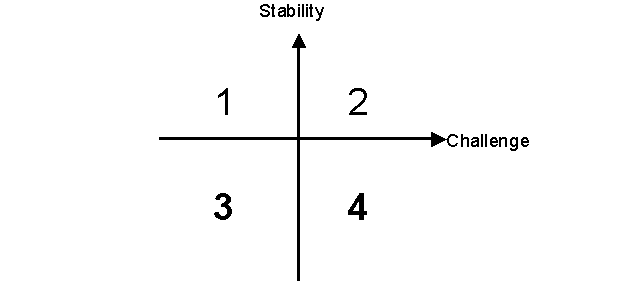
1 = high stability, low challenge (best case)
2 = high stability, high challenge (system can cope with the challenge)
3 = low stability, low challenge (in case of a challenge the system can not cope)
4 = low stability, high challenge (worst case)
The stability of the system depends on the ability to identify and eliminate BSE-infected animals before they are processed. Therefore, the following risk factors have to be considered:
The ability of the system to avoid recycling of BSE-infectivity via the feed chain is another essential condition; therefore, the following risk factors have to be assessed:
A further important step in the risk analysis is the assessment of the challenges to the system. To introduce BSE-infectivity in a country, an initial challenge must take place. Important points to evaluate are the importation of live animals; meat and bone meal; and feed stuffs containing such MBM from countries at risk. Finally, it must be possible to assess the likelihood that the BSE agent was imported. To assess the GBR, it is important to take into account the stability of the system and its development over time, as well as the challenges to the system. Assessing how the system copes with the identified challenges is essential.
If BSE (in form of live animals or MBM) were to be imported into a country during a period where the system is stable, infected animals would be excluded from processing and if infective material nevertheless were to slip through, it’s infectivity would be significantly reduced and/or prevented from reaching cattle -- resulting in a low GBR. The same GBR could result if the stability of the system was low, but no challenge occurred (i.e. no imports of potentially infected material).
The Swiss position
In Switzerland a surveillance system was established in 1989. An information campaign was launched to familiarise veterinarians and farmers with the typical symptoms of BSE. Veterinarians were invited to send all cattle with neurological disorders for specialised pathological examination.
In 1990, BSE became a notifiable disease.
In 1996 discussions in Switzerland focussed on elimination of all cattle born before 1990 -- thought to be the main risk group. But with the occurrence of cases born after the feed ban (BAB-cases), it became evident that the definition of the risk group had to be widened.
The surveillance system was based on disease awareness and the willingness of the veterinarians and farmers to report suspected cases. Based on the findings that typical signs are not consistently expressed in animals reaching the clinical phase of the disease and can be confused with those of other diseases, it was supposed that approximately 50% of all clinical cases are detected through mandatory reporting.
Surveillance based on reporting of subjective impressions by producers and veterinarians has its limitations. A preferred approach would be targeted surveillance based on active case detection among defined risk cohorts. Availability of a fast test makes this approach possible. Thus, it was decided to use such a test for screening risk populations; first on a small scale for purposes of evaluation of the test system; now on a larger scale so as to complement the already existing surveillance system in Switzerland.